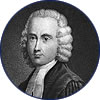Jonathan Dickinson
1688–1747 B.A. 1706
|

|
In 1709 a young minister named Jonathan Dickinson set out for the Colonies’ far western frontiera settlement later known as Elizabeth, New Jersey. Indian attacks, epidemics, and religious strife posed a challenge for the 21-year-old, just three years out of Yale. Running a church in those days, especially on the frontier, also meant providing education and health care.
Two of Dickinson’s published works give an idea of his range. His Familiar Letters to a Gentleman, upon a Variety of Seasonable and Important Subjects in Religion ran through several editions in America and England. The other text, That Terrible Disease, Vulgarly Called The Throat Distemper (diphtheria), was based on his firsthand examination and dissection of a victim “newly dead.”
In religion and education, Dickinson showed a strong concern for diversity and tolerance. He persuaded his congregation, in 1717, to switch from Congregational to Presbyterian affiliation and went on to become a leader of the Synod of Philadelphiabelieving more denominations were needed in the Colonies to counter the hegemony of the Church of England. And when his alma mater began to lean heavily on dissenters, Dickinson decided the time had come to challenge the dominance of Yale and Harvard.
Dickinson is remembered today as a cofounder and the first president of Princeton University, originally the College of New Jersey, which held its first classes in May 1747 in his home.

